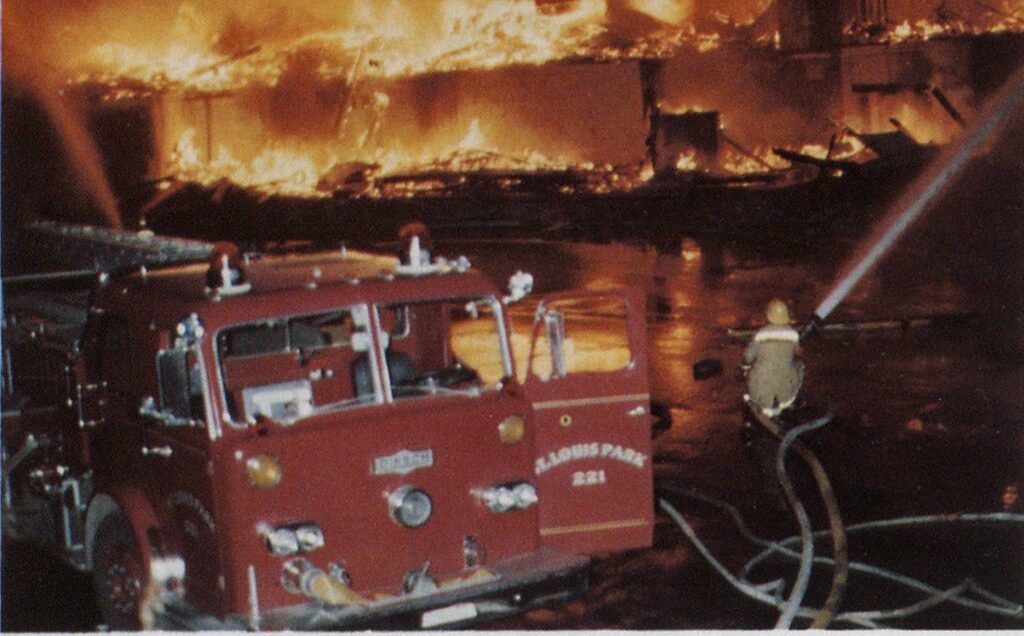
Fire in Uncompleted Building Goes Undetected for an Hour
features

The fire detection value of providing an all-night watchman at any large construction site was demonstrated by a costly fire at a Golden Valley, Minn., condominium.
A passing police officer discovered the fire more than four hours after a watchman went off duty at the remotely located Laurel Hills condominium project, a three-story, 54-unit building under construction and in the plaster-boarding stage. The officer radioed the first alarm at 2:45 a.m. last Nov. 4, 1981, stating that he saw smoke and flames coming from the upper floors.
Responding from the three Golden Valley fire stat ions were approximately 40 men and the volunteer department’s six pumpers, 100-foot aerial ladder, smoke ext ractor and rescue vehicle. On arrival at 2:50 a.m., the first fire units observed fire engulfing all three floors in the center portion of the Y-type building at 6050 Laurel Ave.
Well-involved
“Flames were rising 40 to 50 feet off the roof,” said Fire Marshal George Erickson. “It was completely out of control and spreading. I didn’t think we’d save anything.”
Only a week before, Erickson had ordered the deep mud driveways leading into the building blacktopped to allow for emergency fire department access.
Fire Chief Robert Hennessey, who had been promoted from assistant chief less than a month before, was the second command officer at the scene. He immediately radioed for mutual aid from other north and south suburban departments.
Within 30 minutes, the Hennepin County Mobile Communications Center (command post) and 19 fire fighting units from St. Louis Park, New Hope, Plymouth, Hopkins, Maple Grove, Robbinsdale, Crystal, Brooklyn Park, Brooklyn Center, Osseo, Edina and Minnetonka were providing assistance at the scene.
“Adjacent St. Louis Park was there within five minutes, and many departments were arriving in less than fifteen minutes,” Hennessey said. “The prompt response helped us save as much of the unoccupied building as we did. There was a problem covering all sides of the sprawling structure because we had 200 feet of spread and it was going like crazy with a tremendous volume of flame and heat.”
Satisfactory water
The water supply was satisfactory, and a dozen master streams were deployed to protect the exposures. The heat and continuing collapse of the unfinished interior of the building kept the fire fighters from using hand lines and entering the structure in the early stages of the fire. However, six hand lines were brought inside later through the southwest and north wings of the building.
A total of some 25 lines were laid from a dozen pumpers, including two long lines, each of which was relayed by three pumpers.
There were no injuries. Prevention of exhaustion among the 150 fire fighters from Golden Valley and 12 other mutual-aid departments was accomplished by frequent replacement of personnel.
The fire was under control at 6 a.m., but some fire units remained at the scene most of the day to extinguish small rekindles.
Damage estimates are in excess of $2.5 million, making it the largest dollar loss fire in the history of Golden Valley, a 10.5-square-mile western suburb of Minneapolis with a population of 25,000. Value of the condominium building when finished would have been $5.2 million.
Radio procedures to change
An improvement in radio identification of arriving fire units at mutual-aid alarms will be made as a result of this fire, Hennessey pointed out. Many of the incoming fire rigs identified themselves only by their regular four-digit number, such as 3586, and asked for instruction from the command post.
“When you’re the fire command officer and you’ve got many things on your mind, it’s impossible to identify the type of rig a neighboring department is sending in only by a four-digit number, and there isn’t time to look it up on a list,” explained Hennessey.
“From now on at mutual-aid responses, arriving units will identify themselves by community, type of unit and number,” he said, “such as Golden Valley pumper 3586.”
That way, the fire chief noted, there will be instant recognition by command officers “who then can assign arriving fire companies quickly and efficiently.”
Investigation
While the fire investigation remains open, it is the opinion of Erickson that the most likely cause of ignition may have been heat buildup around one of the recessed electric lights that had been left on all night in the ceiling of a second or third floor corridor in the southwest wing.
Erickson also believes the fire burned for an hour or more before it was discovered by the passing police officer from a distance of several blocks.
“The construction site watchman was on duty only until 10 p.m.,” Erickson said. “If a watchman had been on duty all night, this fire would have been detected much sooner and damage would have been comparatively small.”
Erickson continued, “It’s lucky the officer happened to see the fire when he did. Another few minutes and there would have been no chance of saving any of the building, which is located in a nonpopulated area.
Ironically, a sprinkler system had just been installed in the center core area of the condominium near where the fire started. The system was scheduled to be turned on the following week.

